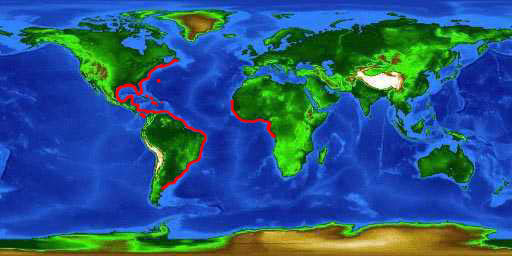
World distribution map for the tarpon
Common Names |
The silver king is the most common pseudonym given to the tarpon by anglers, descriptive of the bright flash that reflects from its large silver scales when it jumps into the air. Other common names include abalitsa, Atlantic tarpon, atlantischer tarpun, bass, big scale, caffum, camurupi, grande ecaille, grand-??caille, grande ecoy, jewfish, madzorfloe, manyofle, mell, ofin, palika, peixe-prata, peixe-prata-do-atlantico, pez lagarto, sabalo, s??balo, sabaloreal, sabilo real, sadina, savalle, savallo, savaloreal, savanilla, silberfisch, silverfish, suwiki, tainha, tainha-congo, tapam, tarpao, tarpoen, tarpom, tarp??n, tarpon argent??, tarpon atlantycki, tarpon trapoen, tarpone tarpone, tarponi, tarpum, trapoen
|
Geographical Distribution |
Tarpon inhabit a large range on both sides of the Atlantic Ocean. The range in the Eastern Atlantic extends from Senegal to the Congo. In the Western Atlantic, the fish primarily inhabit warmer coastal waters concentrating around the Gulf of Mexico, Florida, and the West Indies. However, tarpon are not uncommon as far north as Cape Hatteras, and the extreme range extends from Nova Scotia in the north, Bermuda, and to Argentina to the south. Tarpon have been found at the Pacific terminus of the Panama Canal and around Coiba Island.
|
|
Tarpon populate a wide variety of habitats, but are primarily found in coastal waters, bays, estuaries, and mangrove-lined lagoons within tropical, subtropical, and temperate climates (45?? N-30?? S). The normal habitat depth extends to 98 feet (30 m). Although a marine fish, tarpon can tolerate euryhaline environments (0-47 parts per thousand) and often enter river mouths and bays and travel upstream into fresh water. In addition, tarpon can also tolerate oxygen-poor environments due to a modified air bladder that allows them to inhale atmospheric oxygen. The only variable that seems to limit their choice of habitat is temperature, and research shows tarpon to be thermophilic. Rapid decreases in temperature have been known to cause large tarpon kills. During such temperature drops, tarpon usually take refuge in warmer deeper waters.
|
|